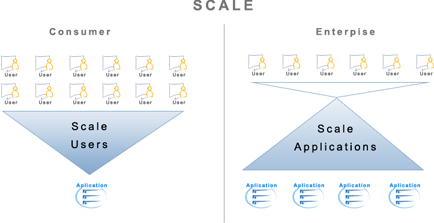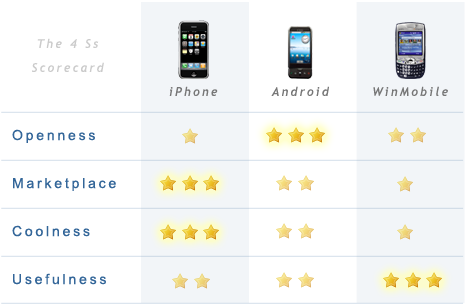June 25th, 2009 by jeremychone | 10 Comments »
 Nowadays, building [rich] Web applications can be quite challenging, as the proliferation of Web technologies has become overwhelming and confusing. The real challenge is that many interesting new Web technologies are being promoted by various groups, and it can be quite difficult for a developer or architect to filter the practical and future-proof ones from the cool and volatile ones.
Nowadays, building [rich] Web applications can be quite challenging, as the proliferation of Web technologies has become overwhelming and confusing. The real challenge is that many interesting new Web technologies are being promoted by various groups, and it can be quite difficult for a developer or architect to filter the practical and future-proof ones from the cool and volatile ones.
As a rule of thumb, open technologies tend to be more pervasive and longer lasting (especially for the Internet) than proprietary technologies, which tend to bring more advanced capabilities early on. Consequently, Web application developers need to be pragmatically-open, by choosing open technologies whenever possible, but also by not hesitating to use proprietary ones when required. It is not about being religious about openness or anything else, but rather about being diligent so that one is able to choose the right technology to maximize the chances of success of the target application. In other words, it should not be a personal and emotional decision, but rather a business and rational one.
Read the rest of this entry »
Posted in Architecture, Open Source, Technology, Web 2.0, Web2.0 | 10 Comments »
June 8th, 2009 by jeremychone | 27 Comments »
 At JavaOne, Larry Ellison has made some very encouraging statements about Oracle’s commitments to Java, JavaFX, and the mobile developer market. It is certainly good news that Oracle (i.e., Larry) sees the significance of the Java platform in its integrality. However, there are many misunderstandings about the relationship between Java, JavaFX, and Android that even confuse the new Java owner. Here are some clarifications.
At JavaOne, Larry Ellison has made some very encouraging statements about Oracle’s commitments to Java, JavaFX, and the mobile developer market. It is certainly good news that Oracle (i.e., Larry) sees the significance of the Java platform in its integrality. However, there are many misunderstandings about the relationship between Java, JavaFX, and Android that even confuse the new Java owner. Here are some clarifications.
1) JavaFX is NOT Java.
Read the rest of this entry »
Posted in Business, Mobile, Technology | 27 Comments »
May 21st, 2009 by jeremychone | 7 Comments »
 So, here we go again; I am starting my second venture. The first one, Sportner, did not work as expected and, thanks to some discipline, I managed to fail fast. Learning from this great experience, I am co-starting a new one, www.ijuris.com. I will talk more about what IntelliJuris actually does later, but for today, I wanted to reiterate my core values going into this venture.
So, here we go again; I am starting my second venture. The first one, Sportner, did not work as expected and, thanks to some discipline, I managed to fail fast. Learning from this great experience, I am co-starting a new one, www.ijuris.com. I will talk more about what IntelliJuris actually does later, but for today, I wanted to reiterate my core values going into this venture.
As well explained in the “Built to Last” book, core values can be a critical factor in the success or failure of an organization. Having been a player in this industry for more than 10 years now, I also strongly believe that core values need to be openly defined and shared, and we need to remind ourselves of them. They often tend to be relegated to the shadowy depths of the hiring binder or put on corporate accessories.
“Build to Last” also has a nice equation defining the relationship between Core Values and Core Ideology:
Core Ideology = Core Values + Purpose
I truely like this formula, and today, I will define and share our core values. They are only three of them:
Read the rest of this entry »
Posted in Entrepreneurship | 7 Comments »
May 19th, 2009 by jeremychone | 15 Comments »
 If you are lucky, and curious enough, Oracle can be the best place to learn the enterprise software market. I have worked at Oracle for about seven years and, in my entire career, it is where I have learned the most about enterprise software. When Oracle announced it was buying Sun, I was actually not that surprised, and I thought it was to be expected after the IBM escape. Oracle is in a self-fulfilling prophecy to consolidate the enterprise software market and, after IBM turned down what could have been a great match for open source and Java, Oracle had to jump in. Larry Ellison and Safra Catz are great market strategists, and Sun should have been on their radar for a long time. Larry has also been good friends with Scott McNealy, and this topic must have come up many times over the years.
If you are lucky, and curious enough, Oracle can be the best place to learn the enterprise software market. I have worked at Oracle for about seven years and, in my entire career, it is where I have learned the most about enterprise software. When Oracle announced it was buying Sun, I was actually not that surprised, and I thought it was to be expected after the IBM escape. Oracle is in a self-fulfilling prophecy to consolidate the enterprise software market and, after IBM turned down what could have been a great match for open source and Java, Oracle had to jump in. Larry Ellison and Safra Catz are great market strategists, and Sun should have been on their radar for a long time. Larry has also been good friends with Scott McNealy, and this topic must have come up many times over the years.
Read the rest of this entry »
Posted in Business, Enterprise Web 2.0, Open Source | 15 Comments »
April 30th, 2009 by jeremychone | 26 Comments »
Software technologists tend to learn by oscillating. We never arrive directly at the right solution; we just come closer to it by going back and forth. We always think (or like to think) that our current solution is correct; only to realize, some years later, that we overshot and need to take a few steps back. The evolution of the software application model is a great example of this syndrome. Every technologist knows about the three main application model phases—Mainframe, Client/Server, and Web [1.0]—and many of them think they know what the next phase will be. In fact, two models are currently being promoted. In order to better understand the current trend, it is important to first understand the three original model phases.
1) Mainframe
The first application model was the mainframe; the client was simply a screen (typically green) and a keyboard that could display and send characters back and forth through a network. The server had all the definitions of the screens (i.e. User Interface), application logic, and data, and was communicating with the client by sending characters (which represented the UI and data) back and forth.
This approach had the benefit of being relatively simple, cost effective to scale, and was easy to manage because the application could be centrally managed. The limitation was obviously that the client’s lack of richness limited the type of application that could be offered. For example, a Google Map on a green screen would have been a challenge to implement.
Read the rest of this entry »
Posted in Architecture | 26 Comments »
March 19th, 2009 by jeremychone | 24 Comments »

In the software industry, and probably in other industries as well, there are two types of startups: the scale-first type and the monetize-first type (sometimes called lifestyle business). Any organization needs to eventually do both, but in the beginning, a startup needs to decide to focus on scale or monetization. Seesmic and Balsamiq are great 2008 examples of each type of startup. (Good comment from Vasudev Ram, Not everyone needs to or wishes to becomes a Google or a Yahoo! or a Microsoft)
Read the rest of this entry »
Posted in Business, Entrepreneurship | 24 Comments »
March 6th, 2009 by jeremychone | 9 Comments »
For quick scan, follow the bold words.
Although there is evidence that the two styles will converge in the future, enterprise and consumer Web architecture and technology are quite different today. If one talks to an enterprise application architect, he or she will probably say that while consumer Web applications are cute, simple, and sometimes useful, their architectures and technologies are merely a bunch of scripts and hacks put together. If one talks to a consumer Web architect, she or he will probably say that enterprise software is overly complex, often unusable, and based on over-priced and under-performing technologies (i.e., JSF or Portal). (See the previous post about Web Developer Spectrum.)
Having lived in both worlds, I can see some truth in both arguments; however, I think that most of the divergence comes from a different set of requirements that leads to separate technical routes.
I see six main differences between consumer and enterprise Web Applications:
1) Scale (Users vs Applications)

Read the rest of this entry »
Posted in Enterprise Web 2.0, Web2.0 | 9 Comments »
October 17th, 2008 by jeremychone | 11 Comments »
Now that Google is in, the game is on. As I mentioned in my previous post, software is now ruling the mobile industry. As in the PC world, the big contenders are Apple with iPhone, Google with Android, and Microsoft with Windows Mobile.
But the big questions are: which one is better and which one is going to ultimately win?
While it is hard to objectively answer this question, here is my first attempt to create a simple score card. I have created a “4 Ss Scorecard” that I think is quite representative of the mobile market need.
Read the rest of this entry »
Posted in Mobile | 11 Comments »
 Nowadays, building [rich] Web applications can be quite challenging, as the proliferation of Web technologies has become overwhelming and confusing. The real challenge is that many interesting new Web technologies are being promoted by various groups, and it can be quite difficult for a developer or architect to filter the practical and future-proof ones from the cool and volatile ones.
Nowadays, building [rich] Web applications can be quite challenging, as the proliferation of Web technologies has become overwhelming and confusing. The real challenge is that many interesting new Web technologies are being promoted by various groups, and it can be quite difficult for a developer or architect to filter the practical and future-proof ones from the cool and volatile ones. At JavaOne, Larry Ellison has made some very encouraging
At JavaOne, Larry Ellison has made some very encouraging  So, here we go again; I am starting my second venture. The first one, Sportner, did not work as expected and, thanks to some discipline, I managed to
So, here we go again; I am starting my second venture. The first one, Sportner, did not work as expected and, thanks to some discipline, I managed to  If you are lucky, and curious enough, Oracle can be the best place to learn the enterprise software market. I have worked at Oracle for about seven years and, in my entire career, it is where I have learned the most about enterprise software. When Oracle announced it was buying Sun, I was actually not that surprised, and I thought it was to be expected after the IBM escape. Oracle is in a self-fulfilling prophecy to consolidate the enterprise software market and, after IBM turned down what could have been a great match for open source and Java, Oracle had to jump in. Larry Ellison and
If you are lucky, and curious enough, Oracle can be the best place to learn the enterprise software market. I have worked at Oracle for about seven years and, in my entire career, it is where I have learned the most about enterprise software. When Oracle announced it was buying Sun, I was actually not that surprised, and I thought it was to be expected after the IBM escape. Oracle is in a self-fulfilling prophecy to consolidate the enterprise software market and, after IBM turned down what could have been a great match for open source and Java, Oracle had to jump in. Larry Ellison and 

